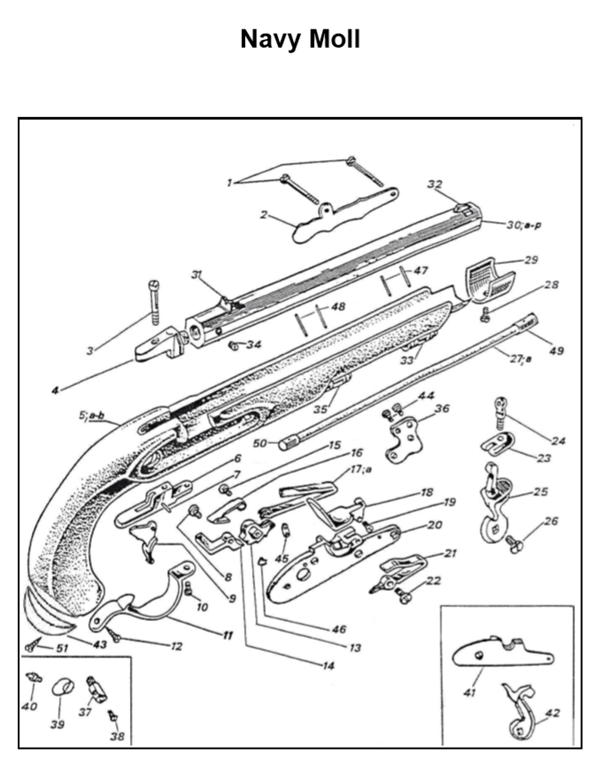CaseHardened
32 Cal.
- Joined
- Feb 23, 2018
- Messages
- 33
- Reaction score
- 1
I purchased a used Pedersoli Navy Moll Flintlock recently, locally. I paid a bit over $400, and am pleased in both saving $$$ and in getting a Used Firearm.
Although everyone loves NEW, I am reluctant to fire a new gun. It devalues them so much ! (yeah, a bit silly, I suppose)
Other than considerable wear to the face of the Frizzen (18), it appears as new.
I've not fired it yet, myself, and wish to be fully informed before I do.

This is my first Flintlock, and I initially did not realize I needed to remove the Barrel (30) and Vent Insert (34) to clean this properly.
I acquired some GRACE Screwdrivers, identified the ones that fit perfectly (G3, H2, N2), and removed the Barrel and Vent Insert with no issue.
But I was surprised to see the full Bore does not extend thru to the Vent Insert, but stops just forward of it. Leaving a much smaller hole that does extend to the Vent Insert.
How can I clean this small internal area properly ?
Should I, can I remove the Breech Plug (04) ?
Is it necessary to do even further disassembly ?
I also noticed the Stock (5), in the normally hidden area that the Barrel fits into, is unfinished.
Should I Wax it ? Shellac it ? Leave it Raw ?
And as an observation, which others have made, the Fore End Cap Screw (28) is really tiny. I suppose Pedersoli knows more than me, but its diminutive size is not reassuring.
Although everyone loves NEW, I am reluctant to fire a new gun. It devalues them so much ! (yeah, a bit silly, I suppose)
Other than considerable wear to the face of the Frizzen (18), it appears as new.
I've not fired it yet, myself, and wish to be fully informed before I do.

This is my first Flintlock, and I initially did not realize I needed to remove the Barrel (30) and Vent Insert (34) to clean this properly.
I acquired some GRACE Screwdrivers, identified the ones that fit perfectly (G3, H2, N2), and removed the Barrel and Vent Insert with no issue.
But I was surprised to see the full Bore does not extend thru to the Vent Insert, but stops just forward of it. Leaving a much smaller hole that does extend to the Vent Insert.
How can I clean this small internal area properly ?
Should I, can I remove the Breech Plug (04) ?
Is it necessary to do even further disassembly ?
I also noticed the Stock (5), in the normally hidden area that the Barrel fits into, is unfinished.
Should I Wax it ? Shellac it ? Leave it Raw ?
And as an observation, which others have made, the Fore End Cap Screw (28) is really tiny. I suppose Pedersoli knows more than me, but its diminutive size is not reassuring.





